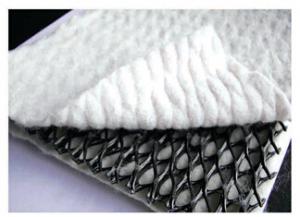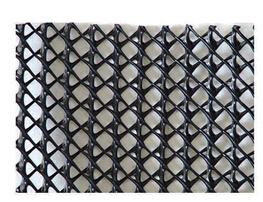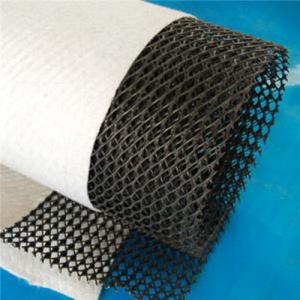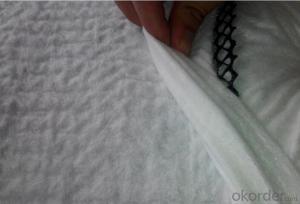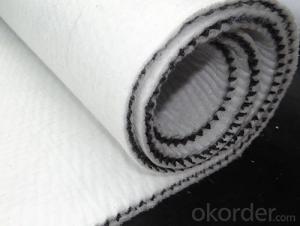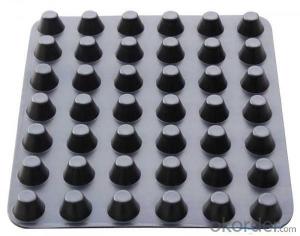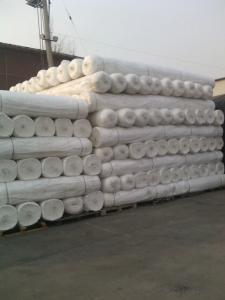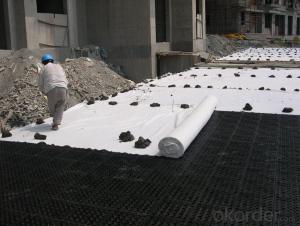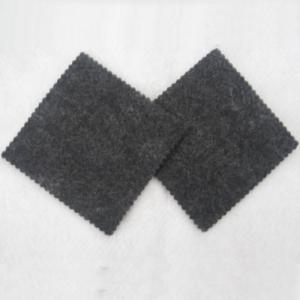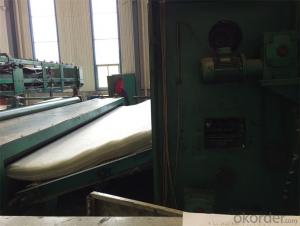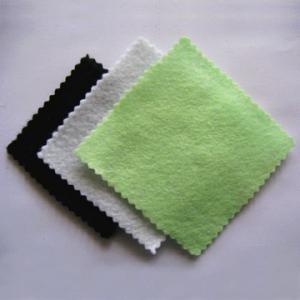Geotextile Filtration Fabric Tri-Dimensional Composite Geonet for Drainage in Road, Railway, Highway, and Tunnel Applications
- Loading Port:
- Tianjin
- Payment Terms:
- TT OR LC
- Min Order Qty:
- -
- Supply Capability:
- 5000rolls m²/month
OKorder Service Pledge
OKorder Financial Service
You Might Also Like
Tri-Dimension Composite Geonet for Drainage 1 for Road Railway Highway Tunnel
It is made of HDPE polymer by extruding into a tri-dimension structure net. Net shape.
Specification of Tri-Dimension Composite Geonet for Drainage 1 for Road Railway Highway Tunnel
Net thickness: 5mm - 8mm, width: 2m - 4m, length as request.
Property of Tri-Dimension Composite Geonet for Drainage 1 for Road Railway Highway Tunnel
I. High drainage property, can bear long time high pressu re
2. High tensile strength and shear strength
3. Reduce probability of geotextile penetration into net to keep high hydraulic conductivity
Application of Tri-Dimension Composite Geonet for Drainage 1 for Road Railway Highway Tunnel
Drainage in landfill, roadbed and road surface, railway, tunnel, underground, retaining wall back
Garden and playground.
Production standard of Tri-Dimension Composite Geonet for Drainage 1 for Road Railway Highway Tunnel
GB/T19470-2004
- Q: Are geotextiles suitable for use in erosion control blankets?
- Yes, geotextiles are suitable for use in erosion control blankets. They are specifically designed to prevent soil erosion by stabilizing the soil and allowing water to pass through while retaining sediment. Geotextiles provide an effective and environmentally friendly solution for erosion control in various applications, including erosion control blankets.
- Q: What are the key considerations for geotextile installation in high-altitude regions?
- When installing geotextiles in high-altitude regions, there are several key considerations to keep in mind. Firstly, the extreme weather conditions typically found in high-altitude areas, such as low temperatures, strong winds, and heavy snowfall, can impact the installation process. Therefore, selecting geotextiles with high durability and resistance to these conditions is crucial. Secondly, proper site preparation becomes even more important in high-altitude regions. The ground should be thoroughly assessed for its stability and potential frost heaving. Adequate measures, such as ground stabilization techniques and proper drainage systems, should be employed to ensure the long-term effectiveness of the geotextile installation. Furthermore, the selection of suitable installation methods is crucial in these regions. The use of specialized equipment and techniques, such as anchoring systems or thermal bonding, may be necessary to counteract the harsh environmental conditions and ensure proper geotextile performance. Lastly, it is essential to consider the environmental impacts of the geotextile installation in high-altitude regions. This includes adhering to local regulations and best practices to minimize disturbance to sensitive ecosystems and wildlife habitats. Overall, key considerations for geotextile installation in high-altitude regions include selecting durable materials, conducting thorough site preparation, using suitable installation methods, and addressing environmental concerns.
- Q: What are the factors to consider when selecting geotextiles for a project?
- When selecting geotextiles for a project, there are several factors to consider. Firstly, it is important to assess the specific requirements of the project. This includes considering the expected load and stress that the geotextiles will need to bear, as well as the expected site conditions such as soil type and water flow. Additionally, the durability and longevity of the geotextiles should be considered, taking into account factors such as UV resistance and resistance to chemical degradation. The cost and availability of the geotextiles should also be taken into account, as well as any specific design or regulatory requirements for the project. Lastly, it is crucial to consider the manufacturer's reputation and the geotextiles' performance history through references and testing data. Overall, a comprehensive evaluation of project requirements, performance characteristics, cost, and availability will help in selecting the most suitable geotextiles for a project.
- Q: What are the key factors affecting the creep behavior of geotextiles?
- The key factors affecting the creep behavior of geotextiles include the type and quality of the material used, the load or stress applied to the geotextile, the duration of the load, and the environmental conditions in which the geotextile is placed.
- Q: Cement concrete bridge is a film curing or geotextile maintenance
- Commodity concrete pouring is completed, should be in the slurry after grinding as soon as possible to cover and sprinkler conservation. Commodity concrete bridge deck with full coverage of sprinkler conservation methods, covering materials with two sticky one geotextile, every 1t sprinkler once, to ensure the quality of conservation, to prevent cracks.
- Q: Are geotextiles resistant to insect infestation?
- Yes, geotextiles are generally resistant to insect infestation. Their synthetic material and tightly woven structure make it difficult for insects to penetrate or nest within the fabric. However, it is important to note that while geotextiles provide a barrier against insects, they are not completely immune to all types of infestation.
- Q: Geotextile is what kind of material in the construction? Is it a hydroelectric material?
- Is not geosynthetics, also known as "geotextile", "geotextile", it is synthetic fiber, plastic, synthetic rubber as raw materials made of different kinds of products, the use of the process of separation, reinforcement, drainage, filtration, , Seepage six basic functions. Abroad in the thirties began to use, so far its products from a single textile development to other synthetic materials and composite materials. Now geosynthetics has been called with steel, cement, wood par, "the fourth engineering materials", and widely used in geotechnical, water and civil engineering and other fields.
- Q: What are the factors to consider when installing geotextiles?
- When installing geotextiles, several factors need to be considered. These include the type and quality of the geotextile material, soil conditions, site preparation, proper installation techniques, and the intended purpose of the geotextiles. It is important to assess the site's drainage requirements, load-bearing capacity, and potential for erosion. Additionally, factors like climate, anticipated traffic loads, and environmental considerations should also be taken into account to ensure the successful installation and functionality of geotextiles.
- Q: Geotextile price geotextile how much money a square meter
- Geotextile is a new type of building materials, raw materials are polyester, polypropylene, acrylic, nylon and other polymer polymer synthetic fiber. In accordance with the manufacturing method is divided into: there are two types of geotextile and non-woven geotextile. According to the use of anti-seepage, anti-filter, drainage, isolation, reinforcement, protection, sealing and so on a variety of functions, based on a variety of factors, the price is not the same, we would rather discuss with the price, Hongxiang new materials company Meng Xiangyu that sell products is not just look at profits, if only the simple pursuit of profit level, it is too easy, but if you want to assume the responsibility of the consumer, the quality of the project Responsibility, but need to spend a lot of effort. To this end, we do not count the cost, put a lot of manpower and resources to innovation, to transform, choose the best materials and the best modern equipment, put a lot of manpower, material resources to innovation, to create brand value, Can create the greatest green benefits. High-end quality and green is a commitment, we promise not to short-term interests, betray the future!
- Q: Can geotextiles be used for erosion control in coastal dunes?
- Yes, geotextiles can be used for erosion control in coastal dunes. Geotextiles are often used as an erosion control measure in coastal areas to stabilize the soil and prevent erosion caused by wind and water. They can be installed on the dune slopes to prevent sand movement and promote vegetation growth, thereby maintaining the integrity of the dune system and protecting it from erosion.
Send your message to us
Geotextile Filtration Fabric Tri-Dimensional Composite Geonet for Drainage in Road, Railway, Highway, and Tunnel Applications
- Loading Port:
- Tianjin
- Payment Terms:
- TT OR LC
- Min Order Qty:
- -
- Supply Capability:
- 5000rolls m²/month
OKorder Service Pledge
OKorder Financial Service
Similar products
Hot products
Hot Searches
Related keywords
